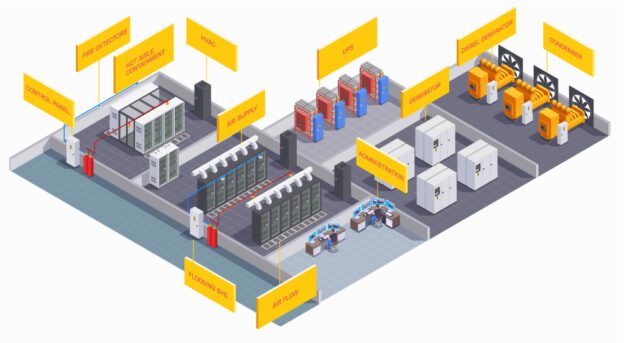Data centres are the backbone of today’s digital landscape, serving as vital hubs propelled by Industry 4.0 technologies, facilitating seamless communication, robust analytics, intelligent controls, and secure data storage. These centres are meticulously designed and constructed, varying in criticality and availability levels to ensure optimal efficiency in supporting business operations.
Data centres’ operational and maintenance facets revolve around a Reliability-centred Maintenance program meticulously tailored to meet stakeholder expectations and requirements. Establishing a comprehensive maintenance policy and strategy tailored to the unique needs of a data centre involves the creation of service-level agreements with a proficient and dedicated team.
To ensure the seamless functioning of data centres and their alignment with statutory, regulatory, and business imperatives, Key Performance Indicators (KPIs) play a pivotal role. These KPIs must resonate with the organisation’s strategic objectives and be easily adaptable by the operational team. They need to be easily tracked and controlled, and most importantly, they need to catalyse sustainable improvements in the following critical parameters.
- Compliances
- Statutory and Regulatory Requirements
Detail the specific regulations and standards the data centre must comply with (e.g., GDPR, Privacy & Security, ISO, and ESG standards), and measure compliance levels against each code separately.
- Standard Operating Processes
Regular audits or checks to ensure adherence to SOPs, with identified areas for improvement and training needs.
- Business Goals
Define and quantify how data centre activities contribute to achieving broader business objectives. Track progress against these goals.
- Infrastructure Sustainability
- Water Efficiency
Implement water usage monitoring systems to track and optimise water consumption.
- Energy Efficiency
Monitor and improve PUE by optimising cooling systems, hardware efficiency, and renewable energy usage.
- Percentage Share of Green Energy
Set targets to increase the proportion of energy sourced from renewable sources and evaluate progress regularly.
- Waste Reusability/Recyclability
Establish a waste management program, track the volume of waste recycled or reused, and set goals for improvement.
- System Uptime
Measure and report on uptime metrics, identifying root causes for downtime to minimise disruptions.
- Cost Efficiency
Conduct regular cost-benefit analyses to identify opportunities for cost reduction without compromising performance.
- Space Efficiency
Utilise data centre space optimally and consider metrics like space utilisation percentage or rack occupancy rates.
- System Utilization
Monitor server utilisation rates and allocate resources efficiently to meet demand without underutilising or overprovisioning.
- Demand Forecasting
Use historical data and predictive analytics to enhance accuracy in forecasting demand for computing resources.
- Reliability, Availability, and Maintainability
Implement preventive maintenance schedules and track metrics such as MTBF, MTTR, and overall system availability.
- Finance
- Operating Cost Efficiency
Break down operational costs and track efficiency improvements over time, aiming to reduce costs per transaction or unit.
- Construction, Refurbishment Cost Efficiency
Evaluate the effectiveness of capital expenditure on infrastructure upgrades or new construction projects.
- Health and Safety
- Life and Fire Safety
Conduct regular fire safety drills and inspections, ensuring compliance and readiness for emergencies.
- Health Wellness of Operating Team Members
Implement wellness programs, conduct health assessments, and gather feedback to improve the well-being of the operational staff.
- Security
- Physical Security Breaches
Strengthen physical security measures and track incidents or breaches to identify weak points for improvement.
- Cyber Security Breaches
Regularly test and update cybersecurity measures, track incidents, and assess the severity and impact of breaches to fortify defences.
By expanding and refining these KPIs, data centre operators can effectively measure and improve various aspects of their operations, ensuring alignment with organisational objectives, compliance with regulations, sustainability, cost-effectiveness, safety, and security. Regularly reviewing these metrics allows for adjustments and enhancements to drive continuous improvement in modern-day data centre operations.

